NOTICES
DEPARTMENT OF CONSERVATION AND NATURAL RESOURCES
Retention of Engineering Firms; Bridge Design, Analysis and Inspection; Project Reference No. FDC-500-813
[49 Pa.B. 2722]
[Saturday, June 1, 2019]The Department of Conservation and Natural Resources (Department) is seeking proposals from qualified professional firms for open-end contracts for bridge design, analysis and National Bridge Inspection Standards (NBIS) inspection, and related services for Department-owned bridges located on State Parks and State Forest land in this Commonwealth. The contract will be for a 12-month period with four 12-month extensions possible. Projects will be assigned on an as-needed basis to ensure proper and safe operation of Department infrastructure and facilities.
The number of open-end contracts and the dollar amount of each contract shall be at the discretion of the Department for the first year. The extent of the work for the subsequent 4 years of the contract will be dependent on the availability of additional funds and additional projects for those years, also at the discretion of the Department.
Letters of Interest for this project will only be accepted from individuals, firms or corporations duly authorized to engage in the practice of engineering or architecture, or both. If an individual, firm or corporation not authorized to engage in the practice of engineering or architecture, or both, desires to submit a Letter of Interest, the individual, firm or corporation may do so as part of a joint venture with an individual, firm or corporation which is permitted under State law to engage in the practice of engineering in this Commonwealth.
Background
Established on July 1, 1995, the Department is charged with: maintaining and preserving the 121 State Parks; managing the 2.2 million acres of State Forest land; providing information on the Commonwealth's ecological and geologic resources; and establishing community conservation partnerships with grants and technical assistance to benefit rivers, trails, greenways, local parks and recreation, regional heritage parks, open space and natural areas.
The Bureau of Facility Design and Construction (Bureau) provides multidisciplined facility and infrastructure technical support to the other bureaus in the Department in the areas of project design, project inspections, construction management, contract administration, surveying, and other technical advice and consultation. This Bureau is comprised of three divisions: Dams, Bridges and Roadways Engineering; Environmental Engineering and Architecture; and Field Engineering and Contracts Management.
The Bureau's Central Office (located in Harrisburg) is responsible for the development of architectural, landscape architectural, water and sanitary, bridge and roadway and civil and environmental projects required to support the Department's facility construction and maintenance program. The Central Office is comprised of five sections: Architectural Design, Landscape Design, Sanitary and Water Management, Bridges and Road Management, and Civil Design. In addition to project design, staff also provides technical architectural and engineering support and advice to assist field operation in State Parks and State Forests.
The Bureau also has four field offices: Northcentral Office in Emporium; Western Office in Moraine State Park; Southcentral Office in Shawnee State Park; and Eastern Office in Nockamixon State Park. Each office is responsible for providing direct engineering and technical support to the State Parks and State Forests field operation staff in their area. Staff is responsible for project inspection and construction management to ensure contractor compliance with the construction contract documents as well as some project design.
PART I
GENERAL REQUIREMENTS I-1. Specific Requirements.
A. The services may encompass a wide range of civil and structural design efforts with the possibility of several different types of projects being designed under short completion schedules. The anticipated types of projects may include, but are not limited to, bridge replacement and rehabilitation (single and multispan), roadway reconstruction/rehabilitation, structural evaluation or design of various bridge types, NBIS inspections and other civil engineering related work as assigned by the Department.
Typically the engineering firm shall be required to furnish a complete set of contract documents (plans and specifications), suitable for public bid and in accordance with a prescribed Department format, and in accordance with PennDOT Design Manual Part IV—Structure, Department of Transportation (DOT) standard drawings (BD and BC) and other applicable State and Federal codes and requirements. A quality assurance program shall be in place by the engineering firm assuring that all documents are acceptable and of the highest quality prior to submission of said documents to the Department.
Areas of related environmental study associated with these design projects may include, but are not limited to, erosion and sedimentation control, wetlands, soil, geology, 25 Pa. Code Chapter 105 (relating to dam safety and waterway management) and Corps of Engineers 404 permits, and Department of Environmental Protection water quality management requirements. The environmental studies shall be conducted in accordance with accepted analysis to techniques and methodologies and may include any or all of the following in order to ensure a complete environmental investigation has been performed; provide all necessary environmental services, material and equipment necessary to collect, analyze and organize data, assess impacts, prepare reports and design mitigation plans. The reports and other graphic material to be prepared may include, but are not limited to, plans of study, meeting minutes, preparation of permit application documents, mitigation plans and reports, and wetland and floodplain findings.
The engineering firm is required to perform any or all of the following duties associated with bridge design: attend site visits; prepare minutes; perform necessary field surveys; plot topography and cross sections; develop erosion control plans; prepare permit applications, prepare type, size and location reports; apply sustainable design and construction practices to mitigate climate change affects; prepare construction drawings, specifications and estimates; procure core borings; provide soil and foundation engineering reports; investigate utility involvement; evaluate alternatives, using benefit/cost analysis; develop other details and narratives; inspect major and unusual structures; develop rehabilitation strategies; and also, review shop drawings, catalog cuts and occasional attendance at construction job conferences may be required.
Projects will be located throughout this Commonwealth. Travel to the project sites will be required. Project assignment will be through individual project Work Orders. The scope of the Work Order may range from full responsibility for all aspects of the design to a collaborative design effort with Department in-house staff where only one or more specific design disciplines are required. Work Orders may be for a single phase or portion of a project such as conceptual design, or for all phases of the entire project. The work shall be identified in the Work Order by a series of tasks that encompass the full scope of the project. The number and description of the tasks will vary based on a project's scope and complexity. The Consultant will be required to develop and maintain a detailed project schedule showing all related project tasks including design phases, submissions, review periods and timelines for required permits. The project schedule shall identify the critical path for completion for the project. A Bureau Project Coordinator will be assigned to each Work Order. The Project Coordinator may change from project to project. A Performance Review may be performed by the Project Coordinator at the completion of the Work Order and used in assigning additional projects to the Consultant.
The Department's standard contract method is multiple prime, design-bid-build, although other nonbid construction methods, including construction by Department staff and volunteer organizations may be used. The Consultant will be required to prepare construction documents appropriate to the construction method selected by the Department.
The Consultant will be required to submit project data and documents in both written and electronic form. Drawings will be required to comply with the Department's computer aided drafting (CAD) standard.
B. Bridge safety inspections must be performed using the DOT's electronic data collection software iForms. The selected engineering firm must utilize the most recent version of iForms to record bridge inspection data in the field and then upload that information to the DOT Bridge Management System 2 (BMS2) database by means of the Internet. To utilize iForms, the selected engineering firm must be registered as a business partner with the DOT. The iForms software is available free of charge and is posted on the DOT's web site.
Inspections must be performed in accordance with the DOT's Bridge Safety Inspection Manual (Publication 238). Inspection types shall consist of the following:
1. Initial (First Time) Inspection.
An NBIS Inspection has not previously been completed. Initial NBIS inspections include load rating to determine the bridge live load capacity. Upload approved shop drawings, load ratings, signed design drawings, bridge inspection data from iForms to DOT's BMS2.
2. Routine Inspection.
An NBIS Inspection has been previously completed. The structure may or may not be included in DOT's BMS2 but a previous inspection report or documentation, or both, is available. Perform load rating analysis if the structural condition changes since the last load rating analysis. Upload bridge inspection data from iForms to DOT's BMS2.
3. Other Special (Interim) Inspection.
Interim inspections are scheduled by the Department to examine bridges or portions of bridges with known or suspected deficiencies. Interim inspections generally focus on specific areas of a bridge where problems were previously reported or to investigate areas where problems are suspected.
4. Damage Inspection.
An NBIS inspection has been previously completed. The structure may or may not be included in DOT's BMS2 but a previous inspection report is available. Perform an inspection that is usually limited to portions of the structure where problems have been found. The information obtained is used by the Department to design needed repairs or the Department may request that the retained engineering firm design the repairs. The information obtained is also used to establish the need to place emergency restrictions or to close the bridge. Damage Inspections are performed on an as-needed basis.
5. In-Depth Inspection.
Perform work to collect data that is difficult to obtain during routine inspections, generally focusing on the entire structure or specific components as authorized by the Department. In-depth tasks may include the following material tests to confirm the existence of or determine the extent of deterioration through the use of: nondestructive testing (except dye penetrant), laboratory analysis, geotechnical sampling and testing, structure instrumentation and underwater inspections. In-depth inspections are performed on an as-needed basis.
6. Damage Inspection.
Perform work beyond the scope of the periodic inspections, assessing the entire structure, focusing on the substructure and its foundation or specific components as authorized by the Department. This could include an underwater inspection. Flood inspections are performed on an as-needed basis.
7. Traffic Control.
Provide traffic control signing and flagging personnel as required.
C. Inspection requirements shall consist of the following:
1. All bridges:
a. Perform a bridge safety inspection.
b. Update/supplement the structure's current condition for the purpose of determining a load rating for the structure. If the current load rating summary indicates that the structure has weight restrictions and new defects are found, determine if a rerating of the structure is warranted. If the structure is to be rerated, use the existing load rating analysis for updating the new load-rating summary. Incorporate the results of the previous or new load-ratings into the report.
c. Update/amend the inspection file by providing new photographic documentation or sketches as needed.
d. Prepare an inspection report to document all work and findings including costs for any repairs.
e. Upload bridge inspection data from iForms to DOT's BMS2.
2. Other types of inspection requirements may be discussed at the scope of work meeting.
3. The work and services which may be required under this agreement encompass all necessary professional and nonprofessional services, work, material and equipment necessary to perform bridge inspection/reinspection and evaluate the condition of Commonwealth-owned bridges and structures at the various locations. The firm will provide updated inspection reports including a bridge load capacity rating/rerating or posting evaluation, or both, and recommendation as warranted. Structure inventory and appraisal data and completed BMS2 coding sheets are also to be furnished.
D. Personnel assigned by the engineering firm to complete the NBIS Inspections shall meet the requirements set forth in the NBIS for all work levels. Inspection personnel must hold a valid certification as ''Bridge Safety Inspector'' issued by DOT.
I-2. Qualifications. The Consultant shall have staff available to provide rapid services associated with assigned projects. The Consultant may be called upon to provide services on multiple projects at the same time. The Consultant shall have demonstrated knowledge of the bridge design, analysis, construction and inspection methods.
The following minimum qualification will be expected of all Consultants:
• Possess current professional registrations required to perform required services.
• Be licensed to conduct business in this Commonwealth.
• Have sufficient staff or subconsultants experienced in the various required services.
• Have an established quality control and assurance program for checking documents for accuracy, consistency, coordination, quality and compliance with all necessary codes and regulations.
• Have design capabilities in digital format (AutoCAD).
I-3. Addenda to the Request for Proposals (RFP). If the Department deems it necessary to revise any part of this RFP before the proposal response date, the Issuing Office will post an addendum to the Department web site at https://www.dcnr.pa.gov/Business/ConstructionBids/Pages/default.aspx. It is the Offeror's responsibility to periodically check the web site for any new information or addenda to the RFP. Answers to the questions asked during the questions and answers period also will be posted, as necessary, to the web site as an addendum to the RFP.
PART II
PROPOSAL REQUIREMENTS Offerors must submit their proposals in the format, including heading descriptions, outlined as follows. To be considered, the proposal must respond to all requirements in this part of the RFP. Offerors should provide any other information thought to be relevant, but not applicable to the enumerated categories, as an appendix to the proposal.
II-1. Requirements. Proposals shall include the following items and information:
• Letter of Interest including the Consultant's Federal identification number and the project reference number.
• A description of the Consultant's understanding of the Department's needs and the services required. This description shall include why and how the Consultant is qualified to provide these services.
• A description of the Consultant's project approach and methodology, including the approach to the managerial, technical and administrative aspects of the project. Describe how the scope, schedule, budget and quality of a project are managed and controlled. Address communication and coordination strategies internal to the design team, with the client and with other outside agencies. Describe how an integrated design process is approached and has been used on past projects.
• A detailed description of the consultant's quality control and assurance program, including how subconsultants are included in this program. Describe what steps are taken to assure accurate, fully coordinated construction documents. Provide the name of the person responsible for quality control and describe their qualifications to perform this task.
• A description of the Consultant's qualifications to complete the required services. Include firm history and experience on similar projects. Describe the resources of the firm, including number/discipline of personnel, ability to respond to schedule acceleration, and the like. Describe roles and experience of proposed subconsultants.
• Resumes of personnel who will be involved in providing the services described herein to the Department. Describe their relevant experience, years of experience, what roles they will fill in providing the required services and percent of time they will be committing to Department-assigned projects. The resumes must include their professional education and professional registrations and licenses. Provide resumes of subconsultant's personnel.
• A description of the Consultant's ability to work on multiple projects of various sizes at the same time.
• A list of at least three of the Consultant's most recent completed projects similar to the projects anticipated under the contract. In addition to photographs and a descriptive narrative, the list shall include the client, contact person and contact information, the completion date, the estimated or actual total construction cost, the estimated or actual construction cost of the portion of the work which the firm designed, the firm's project manager and the names of all of the firm's personnel who made contributions to the project.
• A standard Department of General Services (DGS) Form 150-ASP indicating the individual in charge. The Form 150-ASP is available to download from the DGS Home Page on the Internet at https://www.dgs.pa.gov/Businesses (search for document Form 150-ASP). A sample of this form is found in Appendix A. This form should be submitted electronically on the CD or flash drive as per Part II, II-2 of the RFP. The electronic submission instructions on the DGS web site are for DGS projects only. Additional information pertinent to this firm's qualifications to do the work of this contract may be included.
II-2. Number of Copies. Offeror's Proposals must be submitted electronically on a CD or flash drive in quantity of six each and include DGS Form 150-ASP. Offerors must provide their Small Business Certificate as separate pdf file on the CD or flash drive. Submittals must be accompanied by the Letter of Interest and received no later than 4 p.m. on July 10, 2019. The assignment and services will be made to one or more of the firms responding to this notice. However, the Department reserves the right to reject all Letters of Interest submitted, cancel the solicitation requested under this notice, or readvertise solicitation for this service, or both.
II-3. Small Diverse Business and Small Business Information.
The offering firm must be a self-certified Small Business (SB)/Small Diverse Business (SDB) verified by the DGS, Bureau of Small Business Opportunities (BSBO).
The Department encourages participation by SDBs and SBs as prime contractors and encourages all prime contractors to make significant commitments to use SDBs and SBs as subcontractors and suppliers.
A SB must meet each of the following requirements:
• The business must be a for-profit, United States business.
• The business must be independently owned.
• The business may not be dominant in its field of operation.
• The business may not employ more than 100 full-time or full-time equivalent employees.
• The business, by type, may not exceed the following 3-year average gross sales:
o Procurement goods and services: $20 million
o Construction: $20 million
o Building design services: $7 million
o Information technology goods and services: $25 million
A SB must complete the DGS/Bureau of Diversity, Inclusion and Small Business Opportunities (BDISBO) self-certification process. Additional information on this process can be found at https://www.dgs.pa.gov/Small%20Business%20Contracting%20Program/Pages/default.aspx.
A SDB is a DGS-verified minority-owned SB, woman-owned SB, veteran-owned SB, service-disabled veteran-owned SB, LGBT-owned SB, disability-owned SB, or other SB as approved by DGS, that are owned and controlled by a majority of persons, not limited to members of minority groups, who have been deprived of the opportunity to develop and maintain a competitive position in the economy because of social disadvantages.
A SDB must complete the DGS verification process. Additional information on this process can be found at https://www.dgs.pa.gov/Small%20Diverse%20Business%20Program/Pages/default.aspx.
An Offeror that qualifies as a SDB or a SB and submits a proposal as a prime contractor is not prohibited from being included as a subcontractor in separate proposals submitted by other Offerors.
A SDB or SB may be included as a subcontractor with as many prime contractors as it chooses in separate proposals.
The Department's directory of self-certified SB and DGS/BDISBO-verified SDBs can be accessed from https://www.dgs.pa.gov/Businesses/SmallDiverseBusinessProgram/Small-Diverse-Business-Verification.
Questions regarding the SDB and SB programs, including questions about the self-certification and verification processes, can be directed to the Department of General Services, Bureau of Diversity, Inclusion and Small Business Opportunities, Room 601, North Office Building, Harrisburg, PA 17125, (717) 783-3119, fax (717) 787-7052, RA-BDISBOVerification@pa.gov, www.dgs.pa.gov.
II-4. Debriefing. The Department will not offer a debriefing session to the unsuccessful firms. The Department disclaims any liability whatsoever to its review of the proposal submitted and in formulating a recommendation for selections. Recommendations made by the Department shall be final.
PART III
CRITERIA FOR SELECTION III-1. Selection Criteria. The engineering consulting firm will be evaluated upon, but not limited to, the following criteria:
A. Professional's understanding of the problem as demonstrated in Letter of Interest.
B. Qualifications of firm.
C. Professional personnel in firm and available manpower to perform the services required.
D. Soundness of approach as demonstrated in Letter of Interest, and as stated in their own interpretation of the tasks to be performed.
E. Quality control and assurance program and procedures of the firm.
F. Equitable distribution of contracts.
G. Offerer is a self-certified SB. To be eligible for selection for this project the Offerer's firm must be a self-certified SB/SDB verified by the DGS, BSBO. Refer to Part II, II-3.
III-2. Number of Contracts. The Department may select more than one firm.
PART IV
MAILING AND CONTACT INFORMATION Firms interested in performing the required services for this project are invited to submit Letters of Interest to Alfred Uzokwe, Sr., PE, Director, Bureau of Facility Design and Construction, Rachel Carson State Office Building, 8th Floor, 400 Market Street, P.O. Box 8451, Harrisburg, PA 17105-8451. Contact Wayne Nguyen at (717) 787-9292 for general information concerning this RFP.
CINDY ADAMS DUNN,
Secretary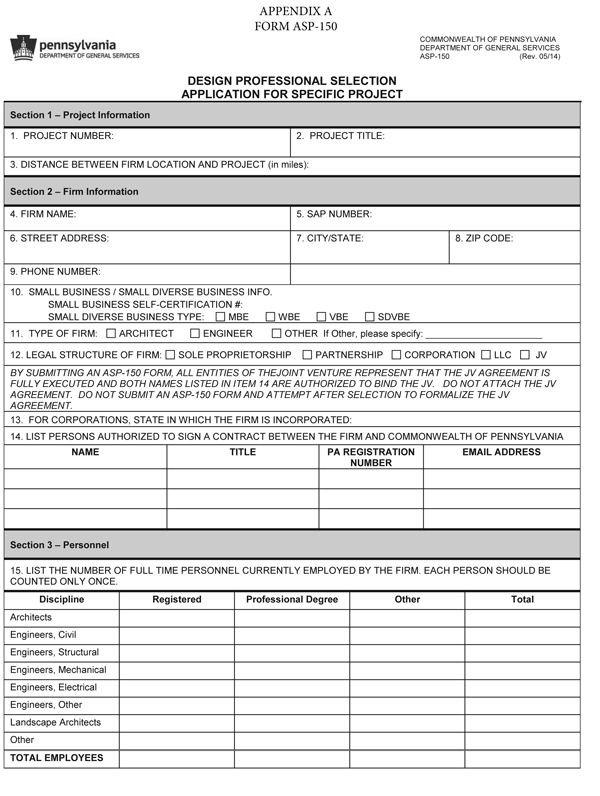
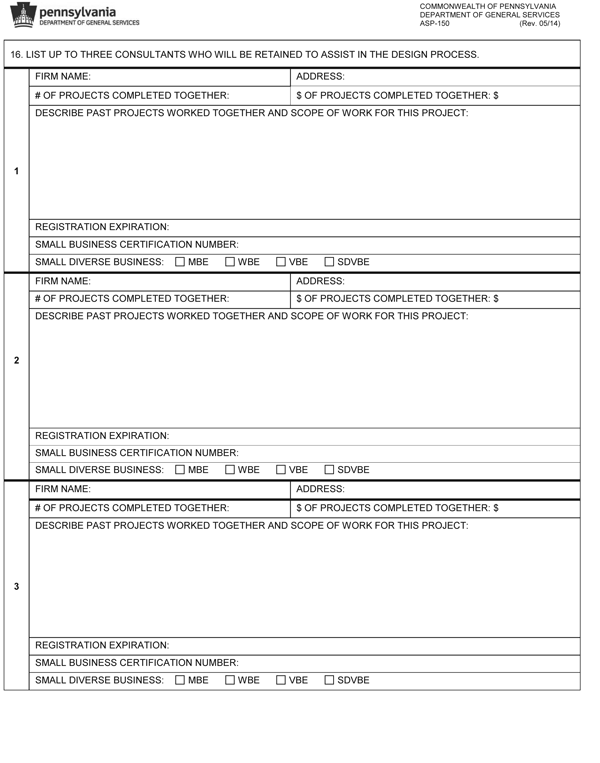
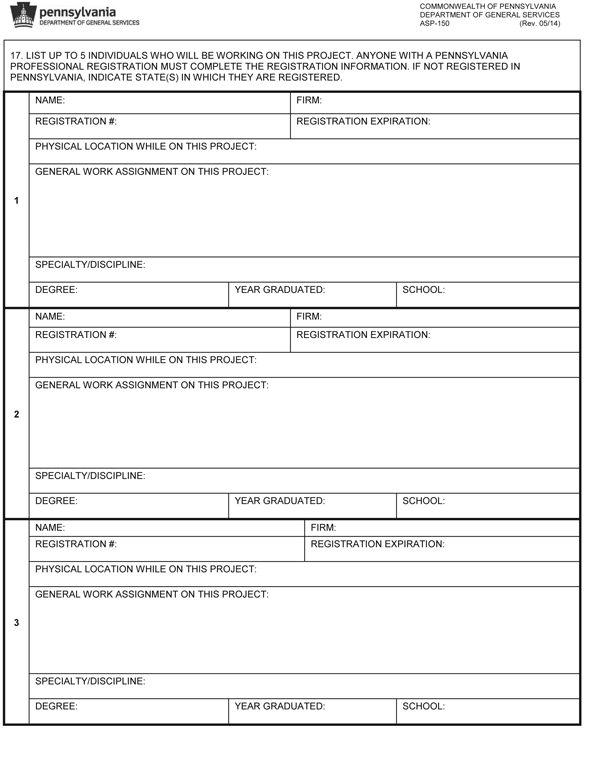
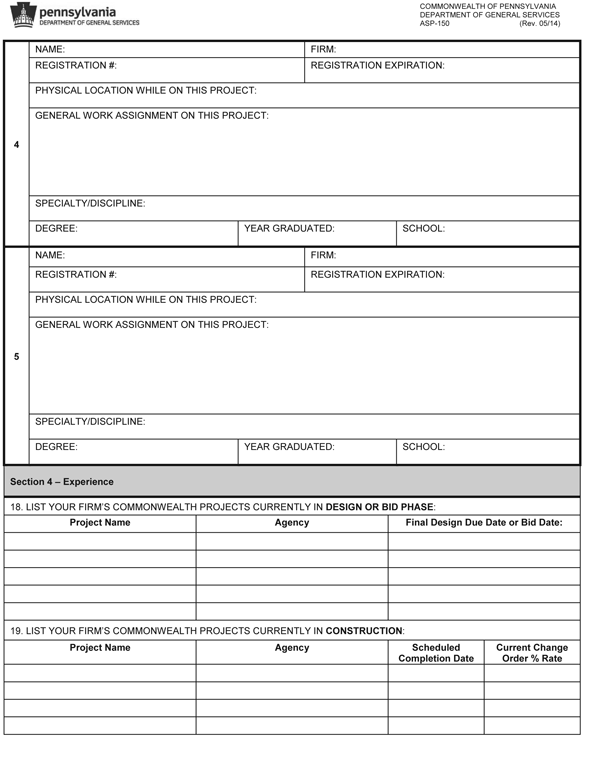
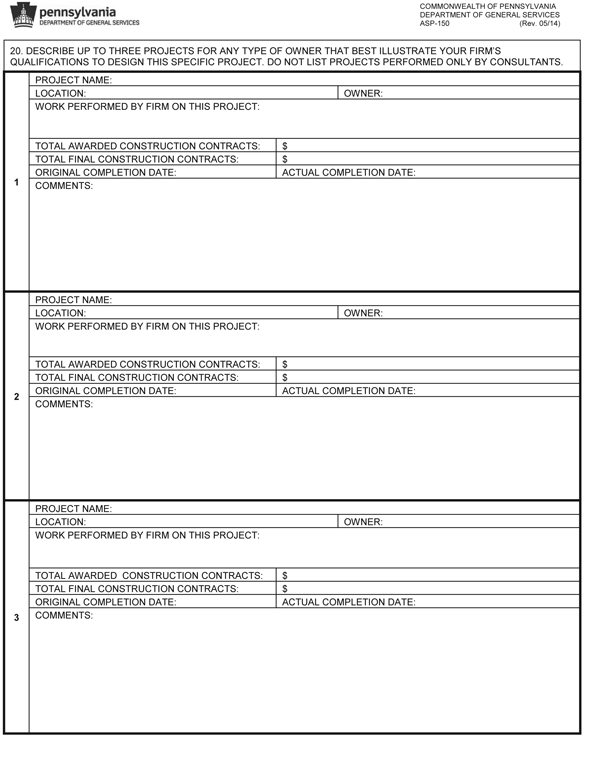

[Pa.B. Doc. No. 19-823. Filed for public inspection May 31, 2019, 9:00 a.m.]
No part of the information on this site may be reproduced for profit or sold for profit.This material has been drawn directly from the official Pennsylvania Bulletin full text database. Due to the limitations of HTML or differences in display capabilities of different browsers, this version may differ slightly from the official printed version.